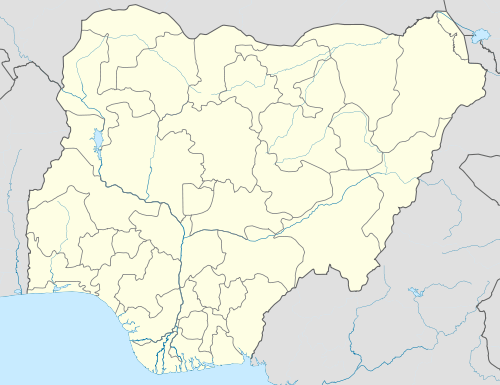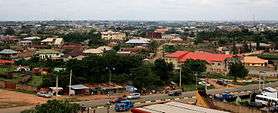Osogbo
| Osogbo Osogbo Oroki | |
|---|---|
| LGA and city | |
 Osogbo | |
| Coordinates: 7°46′N 4°34′E / 7.767°N 4.567°E | |
| Country |
|
| State | Osun |
| Area(LGA) | |
| • Total | 47 km2 (18 sq mi) |
| Elevation | 320 m (1,050 ft) |
| Population (2006 Census (LGA)) | |
| • Total | 156,694 |
| Time zone | WAT (UTC+1) |
| 3-digit postal code prefix | 230 |
| ISO 3166 code | NG.OS.OS |
| Climate | Aw |

Osogbo (also Oṣogbo , rarely Oshogbo) is the state capital city of Osun. Osogbo city seats the Headquarters of both Osogbo Local Government Area (situated at Oke Baale Area of the city) and Olorunda Local Government Area (situated at Igbonna Area of the city). It is some 88 kilometers by road Northeast of Ibadan. It is also 100 kilometers by road South of Ilorin and 115 kilometers Northwest of Akure;[1] Osogbo shares boundary with Ikirun, Ilesa, Ede, Egbedore and Iragbiji and is easily accessible from any part of the state because of its central nature. It is about 48 km from Ife, 32 km from Ilesa, 46 km from Iwo, 48 km from Ikire and 46 km from Ila-Orangun; The City boasted of a population of about 156,694 people, based on the 2006 Census;[2] the postal code of the area is 230.[3]
Infrastructure and demographics
Osogbo lies on the railway line from Lagos to Kano. It is known for the Osogbo School of Art and the Oja Oba Market building, said to be the former Oba's palace, within yards of the Osogbo Grand Mosque.
Osogbo is the trade center for a farming region. Yams, cassava, grain, and tobacco are grown. Cotton is grown and used to weave cloth. It is also home to several hotels and a football stadium with a capacity of 10,000 and a second division professional league team.
Most of the population are members of the Yoruba ethnic group. In 1988, about 27% of the population were engaged in farming as their primary occupation, 8% were traders and about 30% clerks and teachers.
Culture

Osogbo, sometimes called "Ilu Aro" (home of dyeing), is a major dyeing center. The traditional industry is one of the major industries of Osogbo. A number of industries also began to rise after independence, notably small scale establishments involved in textile, foam making, and pencils. Osogbo was made a major industrial development center by the government of Nigeria during the 1970s. Osogbo is also the childhood home of the actor and dramatist Duro Ladipo and the Muslim scholar Sheikh Adelabu.
Osogbo is the venue of the annual Osun-Osogbo festival along the River Osun. The festival is centered on the sacred grove of the river goddess Ọsun,[4] which is a UNESCO World Heritage Site,[5]
Climate
| Climate data for Osogbo | |||||||||||||
|---|---|---|---|---|---|---|---|---|---|---|---|---|---|
| Month | Jan | Feb | Mar | Apr | May | Jun | Jul | Aug | Sep | Oct | Nov | Dec | Year |
| Record high °C (°F) | 35.5 (95.9) |
37.0 (98.6) |
38.0 (100.4) |
35.0 (95) |
34.0 (93.2) |
33.5 (92.3) |
31.5 (88.7) |
31.0 (87.8) |
32.0 (89.6) |
33.0 (91.4) |
33.5 (92.3) |
34.0 (93.2) |
38.0 (100.4) |
| Average high °C (°F) | 32.8 (91) |
34.6 (94.3) |
34.3 (93.7) |
32.1 (89.8) |
31.2 (88.2) |
30.0 (86) |
27.9 (82.2) |
27.4 (81.3) |
28.8 (83.8) |
30.1 (86.2) |
31.2 (88.2) |
31.9 (89.4) |
31.0 (87.8) |
| Daily mean °C (°F) | 26.2 (79.2) |
27.4 (81.3) |
28.4 (83.1) |
27.1 (80.8) |
26.5 (79.7) |
25.8 (78.4) |
24.3 (75.7) |
23.8 (74.8) |
24.9 (76.8) |
25.4 (77.7) |
26.1 (79) |
26.0 (78.8) |
26.0 (78.8) |
| Average low °C (°F) | 19.5 (67.1) |
20.1 (68.2) |
22.5 (72.5) |
22.1 (71.8) |
21.8 (71.2) |
21.5 (70.7) |
20.7 (69.3) |
20.3 (68.5) |
21.0 (69.8) |
20.7 (69.3) |
21.0 (69.8) |
20.1 (68.2) |
21.0 (69.8) |
| Record low °C (°F) | 10.5 (50.9) |
10.0 (50) |
19.0 (66.2) |
19.5 (67.1) |
18.0 (64.4) |
19.5 (67.1) |
17.0 (62.6) |
16.5 (61.7) |
18.5 (65.3) |
18.5 (65.3) |
14.5 (58.1) |
13.0 (55.4) |
10.0 (50) |
| Average precipitation mm (inches) | 7 (0.28) |
26 (1.02) |
76 (2.99) |
118 (4.65) |
144 (5.67) |
141 (5.55) |
121 (4.76) |
125 (4.92) |
181 (7.13) |
172 (6.77) |
54 (2.13) |
12 (0.47) |
1,177 (46.34) |
| Average precipitation days (≥ 0.3 mm) | 1 | 3 | 7 | 11 | 12 | 15 | 15 | 11 | 17 | 20 | 5 | 1 | 118 |
| Average relative humidity (%) | 74 | 69 | 77 | 84 | 87 | 88 | 89 | 89 | 89 | 89 | 84 | 79 | 83 |
| Source: Deutscher Wetterdienst[6] | |||||||||||||
History
According to tradition, In Ipole Omu, seven (7) rulers reigned before Olarooye in the following succession:
- Adefokanbale
- Aikanya
- Ogbogba
- Saso
- Luberin
- Laege – (Alias Adetuturinrin) father to both Lajomo and Larooye
- Lajomo
- Olarooye
During the reign of Oba Olarooye at Ipole, life became very unbearable because of incessant dry seasons. The then Ipole people became much dejected, worried and uncomfortable over their losses involving their farms, domestic animals and human beings. The Oba Olarooye was worried and disheartened by the situation at Ipole Omu. He wanted emergency solutions to inevitable and uncountable losses. This was the time he ordered the chief hunter at Ipole-in the person of Timehin-and his co-hunters to go on expedition and look for greener pastures. Timehin and the other hunters courageously took up the challenge and moved out in search of a better place for settlement. The expedition discovered River Osun.
Yoruba tradition claims many people fleeing the Fulani Invasion settled at Osogbo following the fall of old Oyo. As a result, Osogbo increased in population largely due to migration from other Yoruba towns.[7]
For want of a more open place than a grove and a more central location, Larooye and his people abandoned their settlement, including the already flourishing market and moved to Ode-Osogbo. At Ode-Osogbo, Larooye built his new palace at the present-day Idi-Osun while Timehin built the Ogun shrine now known as Idi-Ogun. Since then, Osogbo has maintained its function as an economic center.
List of Ataojas (traditional kings)
The Ataoja of Osogbo is the traditional ruler, addressed by the title of Oba. The following is the list of the Ataojas of Osogbo, with the dates of their rule:
- Oba Larooye Gbadewolu d. 1760
- Oba Sogbodede d. 1780
- Aina Serebu 1780-1810
- Abogbe (as Regent, she reigned but did not assume the title Ataoja) 1810-1812
- Obodegbewale (as Regent) 1812-1815
- Oba Lahanmi Oyipi 1815-1840
- Oba Ojo Adio Okege 1840-1854
- Oba Oladejobi Oladele Matanmi I 1854-1864
- Oba Fabode.Durosinmi Ogunnike 1864-1891
- Oba Bamigbola Alao 1891-1893
- Oba Ajayi Olosunde Oyetona 1893-1903
- Oba Atanda Olukeye Olugbeja Matanmi II 1903-1917
- Oba Kofoworola Ajadi Latona I 1918-1920
- Oba Alabi Kolawole 1920-1933
- Oba Samuel Oyedokun Latona II 1933-1943
- Oba Samuel Adeleye Adenle I 1944-1976
- Oba Iyiola Oyewale Matanmi III 1976-2010
The stool of Ataoja of Osogbo is still VACANT ( The only daughter and surviving child of Laroooye is Abogbe, Omunmuyiwa Ogbonke was a serve to Ataoja Gbadewolu Larooye)
See also
References
- ↑ "Welcome to Osogbo City Homepage". OSOGBOCITY WEB. Retrieved 2013-06-21.
- ↑ "Osogbo". OSUN STATE GOVT. Retrieved 2013-05-10.
- ↑ "Post Offices- with map of LGA". NIPOST. Retrieved 2009-10-20.
- ↑ Joseph M. Murphy; Mei Mei Sanford. Reviewed Work(s): Osun across the Waters: A Yoruba Goddess in Africa and the Americas. The International Journal of African Historical Studies > Vol. 34, No. 3 (2001)
- ↑ Peter Probst. Osogbo and the Art of Heritage. Monuments. Deities, and Money. Bloomington: Indiana University Press, 2011
- ↑ "Klimatafel von Oshogbo / Nigeria" (PDF). Baseline climate means (1961-1990) from stations all over the world (in German). Deutscher Wetterdienst. Retrieved 10 August 2016.
- ↑ Tunde Agbola. Osogbo: Cities, Volume 9, Issue 4, November 1992.
External links
- Osun-Osogbo Sacred Grove World Heritage Site
- A Brief History of the Ataoja of Osogbo
- Welcome to Osogbocity Homepage
Coordinates: 7°46′N 4°34′E / 7.767°N 4.567°E
